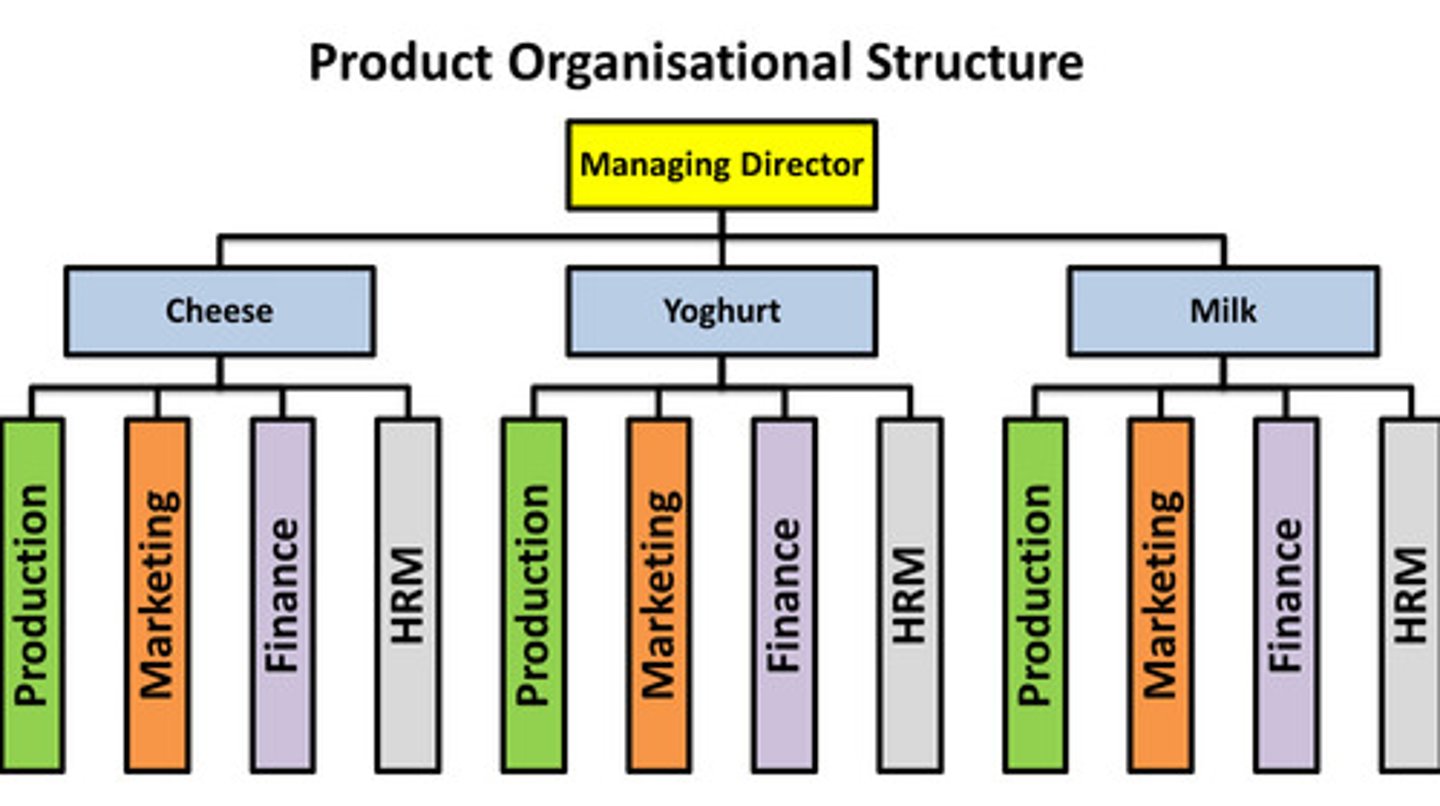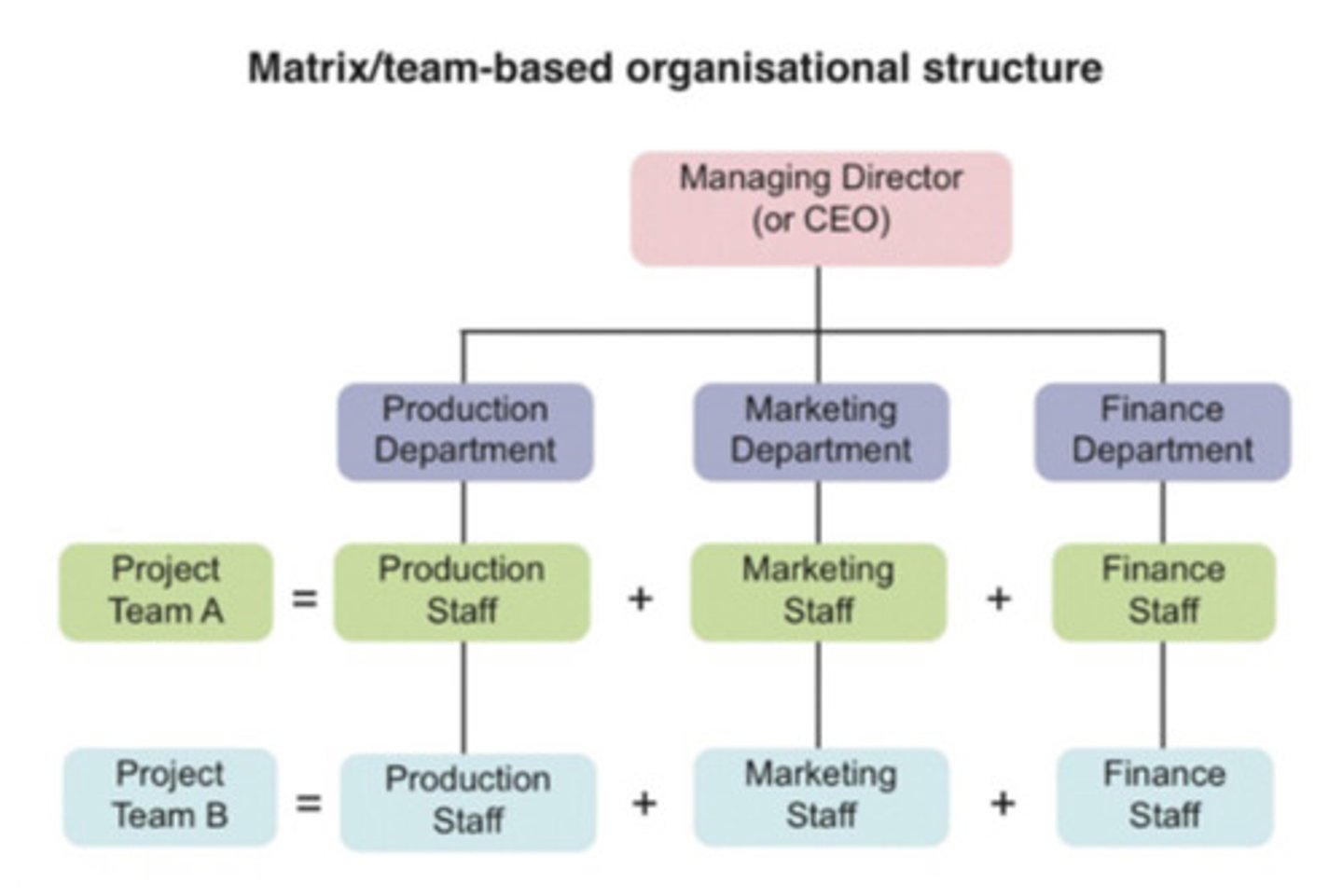3.6.3: Improving organisational design and managing the human resource flow
1/36
There's no tags or description
Looks like no tags are added yet.
Name | Mastery | Learn | Test | Matching | Spaced |
|---|
No study sessions yet.
37 Terms
Organisational structure
shows the lines of authority and layers in the hierarchy of the business.
Functional organisational structure
the business is divided into smaller teams based on specialised functional areas, such as IT,
allows for greater operational efficiency
Product based organisational structure
assigns employees to divisions based on the product

Regional organisational structure
cover a span of geographic regions, it sometimes makes sense to organise by region. This is done to better support logistical demands and differences in geographic customer needs

Matrix organisational structure
A matrix structure provides for reporting levels both horizontally as well as vertically
Employees may be part of a functional group but
may serve on a team that supports new product development

authority
right to give orders and make decisions in an organisation,
Span of control
The span of control of a manager in a business is always a number
This is the number of subordinates that they can delegate to

Hierarchy
a system in a business where employees are
ranked due to their status and authority
Delegation
when the authority to carry out a task or a decision is handed down to another employee
Chain of command
flow of information power and authority through the organisation
Centralisation
the power to make decisions is at headquarters This keeps decision making at the top of the organisational structure
Pros of centralised organisations
-decisions made faster
-tighter control n budgets
-economies of scale as top is doing all the buying
Cons of centralised organisations
-managers have less power to make decisions
-decisions arnt made by those closes to costumers
Decentralisation
Decision making power is given to the regional or branch
managers
Some decisions may still be taken at HQ but staffing issues can be resolved at branch level
Pros of a decentralised organisation
Managers are better able to respond to customer issues and
resolve complaints quickly
Reduction in costs through a flatter organisational structure
Motivating for managers to have more control over decision making
cons of a decentralised organisation
Harder to ensure standardisation and consistency within the business
Decision making is tactical (short-term) not strategic
(long-term)
value of changing organisational design
A business will change their organisational design to gain
competitive advantage
A business may decide to 'delayer' or remove a layer of the
organisation to cut costs and streamline
Human resource flow
a term used to describe the process by which employees pass through the business.
sub-sections Human resource flow
inflow (recruitment and selection),
through-flow (promotion),
outflow (resignation, retirement, dismissal, and redundancy).
Human resource plan
aims to have the right number of employees in the right job roles so that the business can achieve its objectives
Internal recruitment
carried out within the business or organisation
Advantages of internal recruitment
Easier access to applicants and so recruitment process may be
quicker
Less costly than searching outside of the cast or business
Promoted employee is already familiar with processes and
procedures and will take less time to get up to speed
Disadvantages of internal recruitment
Scarce or rare talent may be harder to find within the organisation
Makes a space within the organisation that must be filled,
leading to further recruitment problems
If a known star is wanted they may need to be externally recruited
External recruitment
the selection and hiring of staff from outside of the business
A business can attract candidates through; advertising, websites or the Jobcentre Plus
Advantages of external recruitment
1. New skills and ideas brought to company to improve
2. More experience in position in previous company
Disadvantages of external recruitment
1. Will not know existing teams or employees
2. Will not have specialised knowledge of industry of clients
3. Cost on job adverts
#1 Training: Induction
where new employees first start a job to learn key information about a business:
-Learn about procedures
-Involves meeting colleagues
-Learn systems / health and safety
Advantages of induction training
Helps the employees to learn more about the workplace before they start
Means employees will be more productive
Gives the employees key information e.g. fire evacuation
routes
Reduces stress on employees
disadvantages of induction training
Cost of having an employee not working
Takes time so reduces output
Inadequate content of some induction programmes
Employee may not watch the video or understand the training
materials
#2 Training: On-the-job
any kind of instruction carried out in the workplace
This can mean coaching or mentoring to advise or assist those
new to the role
Helps new workers to become more familiar with specific work
methods needed for their job role
Advantages of on the job training
Specific training needed for the job, for example: how to use a
sewing machine
Less expensive than off-the-job training
Learning can be put in to practice immediately
Disadvantages of on the job training
Taking time away from employees job to be trained
Reduces efficiency of both teaching worker and new employee
Some workers have bad habits they could pass on
The new worker may not pick up the skills straight away/misunderstand/not ask for help
#3 Training: Off-the-job
Involves work at home or courses at company training centres or local colleges may also have suitable courses e.g. accountancy
Employees learn through
demonstrations talks, and lectures
Advantages of off the job training
More focused environment with less distractions
Increases a workers motivation as they feel valued by the company to have money spent on their improvement
Less stressful compared with on the
job
Disadvantages to off-the-job
training
More expensive than on-the-job training
Employees may fail to see link between training and
workplace
Employees are taken away from production so the
business loses their productivity for that day
Redeployment
means that a business is transferring (moving)
a member of staff from one branch or area to another
This may be because their skills are needed in that area or to fill an internal vacancy
Redundancy
occurs when a job no longer exists possibly due to lack of business or restructuring
Voluntary redundancy, where a business needs to cut back on
staff,
Compulsory redundancy is where a member of staff must leave a job,